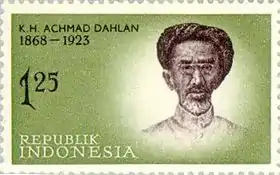Ahmad Dahlan
Kyai Haji Ahmad Dahlan (Arabic: أحمد دحلان; 1 August 1868 – 23 February 1923), born Muhammad Darwis, was an Indonesian Islamic revivalist who established Muhammadiyah in 1912. He became a national hero according to presidential decree number 157 in 1961.



Education
Muhammad Darwis, commonly known as Ahmad Dahlan, was born in the Muslim quarter of Yogyakarta behind the Yogyakarta Sultan's Great Mosque. His father was the Imam of the mosque, and Dahlan learned that language from his father. He was the 12th generation descendant of Maulana Malik Ibrahim with lineage traces back to Muhammad. It is Muslim belief that one should recite the Quran in its original language (however translations can be used for people who can not understand Arabic), but very few Indonesians at this time knew Arabic, and those who could were considered people of great knowledge. Dahlan was sent to an Islamic boarding school or pesantren.[1] As one of his five obligations as a Muslim, he went on a pilgrimage to Mecca where he studied with Ahmad Khatib, the renowned religious teacher. It was during this pilgrimage Dahlan changed his name from Muhammad Darwis to Ahmad Dahlan. This latter name was given by the syaikh of Shafi`i school of law, Sayyid Bakri Shatta.[2] Dahlan associated with fellow Indonesian pilgrims from Sulawesi, West Java, Minangkabau, Aceh and other areas of strong belief, which helped them both conceive of a common interest against the Dutch colonial masters of Indonesia and the need to purify and renew Islam in Indonesia.[3]
Muhammadiyah
After returning to Java around 1888, he married the daughter of the head (imam) of the Great Mosque in Yogyakarta. As one of the growing group who regarded themselves as modernists, he was concerned at the many Javanese practices not justified by Islamic scripture and argued for the creation of a renewed purer Islam more in step with the modern world.[3] The efforts of Western Christian missionaries also concerned him. He joined Budi Utomo in 1909, hoping to preach reform to its members, but his supporters urged him to create his own organization.
He created Muhammadiyah in 1912 as an educational organisation as a means of realising his reformist ideals. It was quickly joined by traders and craftsmen. In 1917 added a women's section named Aisyiyah, which played a significant role in modernising the life of Indonesian women. Spreading to the Outer Islands, Muhammadiyah established a strong base in Sulawesi only a decade later after it was founded. It was one of a number of indigenous Indonesian organisations founded in the first three decades of the twentieth century;a time known as the Indonesian National Revival; that were key in establishing a sense of Indonesian nationalism, and ultimately independence. Today, with 20 million members, Muhammadiyah is the second largest Muslim organisation in Indonesia after Nahdlatul Ulama.[3]
Ahmad Dahlan died, aged 54, in Yogyakarta.
See also
- Islam in Indonesia
- Muhammadiyah
- Winai Dahlan the Founder Director of the Halal Science Center, Chulalongkorn University, who is also the grandson of Ahmad Dahlan.
References
| Wikimedia Commons has media related to Ahmad Dahlan. |
- Vickers (2005), p. 54
- Burhani (2010), pp. 56–7
- Vickers (2005), p. 56
Bibliography
- Burhani, Ahmad Najib. Muhammadiyah Jawa. Jakarta: Al-Wasat, 2010.
- Ricklefs, M.C. A History of Modern Indonesia Since c. 1300, 2nd ed. Stanford: Stanford University Press, 1994.
- Vickers, Adrian (2005). A History of Modern Indonesia. New York: Cambridge University Press. ISBN 0-521-54262-6.
| Preceded by — |
Chairman of Muhammadiyah 1912–1922 |
Succeeded by KH Ibrahim |
